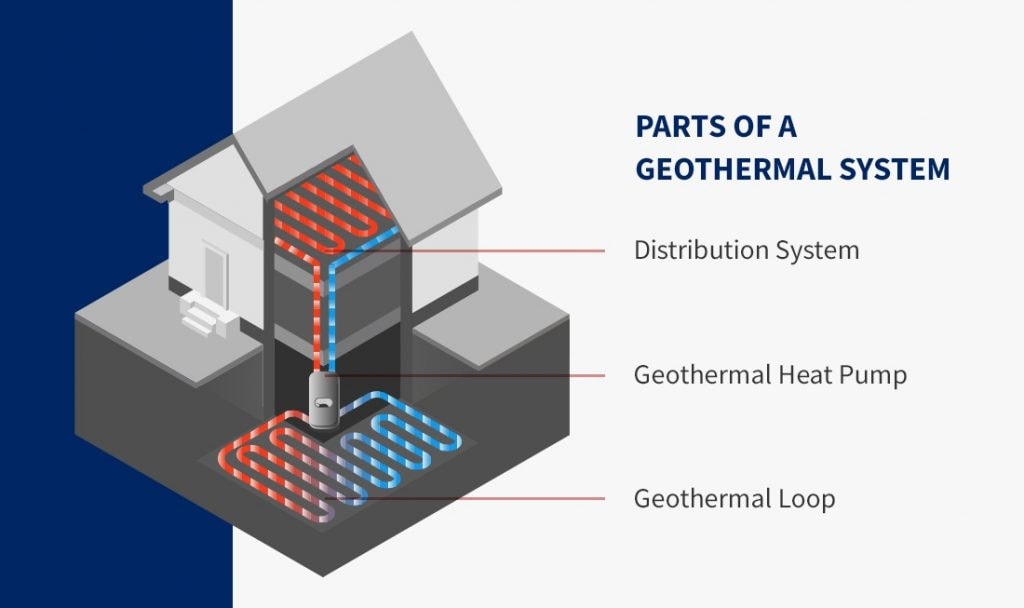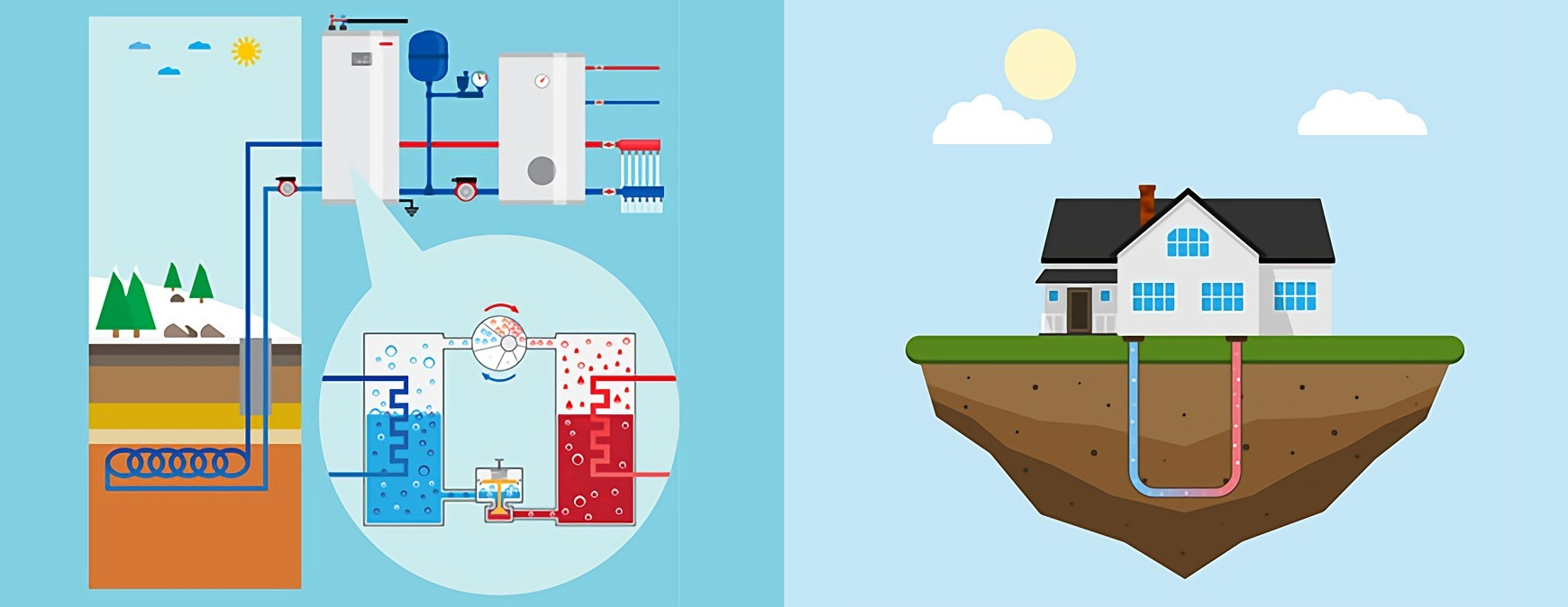Understanding Geothermal Systems: Is Geothermal Heating and Cooling Right for You?
With the growing demand for sustainable and efficient home energy solutions, geothermal systems have emerged as a leading option for heating and cooling high-end residential properties. By tapping into the earth’s natural and consistent underground temperatures, these systems offer unparalleled efficiency, environmental benefits, and long-term cost savings. However, the decision to implement geothermal heating and…
Morgan Poulos Keating, PE
June 20, 2024
14 mins read
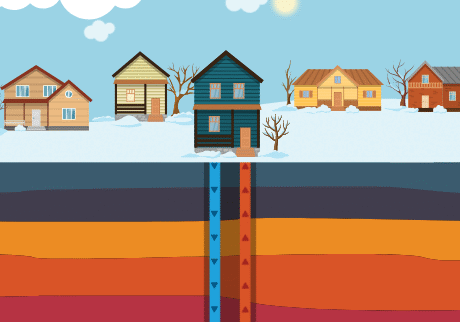
With the growing demand for sustainable and efficient home energy solutions, geothermal systems have emerged as a leading option for heating and cooling high-end residential properties. By tapping into the earth’s natural and consistent underground temperatures, these systems offer unparalleled efficiency, environmental benefits, and long-term cost savings.
However, the decision to implement geothermal heating and cooling involves various factors, including site suitability, installation costs, and maintenance requirements. In this blog, we delve into the fundamentals of geothermal systems, explore their advantages, and provide insights to help you determine if this innovative technology is the right choice for your home or project.
How Do Geothermal Heating and Cooling Systems Work?
Understanding how a geothermal heating and cooling system operates can provide valuable insights into its efficiency and benefits. Let’s explore the core components of these systems, the process of heat transfer, and the different types of geothermal systems available.
Components of a Geothermal Heat Pump System
A geothermal heat pump system consists of several key components that work together to transfer heat between the structure and the ground:
- Ground loop system: This network of pipes, buried underground or submerged in water, circulates a fluid (water or antifreeze solution) that absorbs and dissipates heat. The ground loop system is responsible for the heat exchange process between the earth and the heat pump.
- Geothermal units: The heart of the system, the geothermal units, are typically installed indoors. They extract heat from the ground loop system during the winter and transfer it into the building. During the summer, the process is reversed, and the geothermal units remove heat from the building and dissipate it into the ground. These units are highly efficient and can also supply hot water, offering significant cost savings in the long run compared to air-source heat pumps.
- Distribution system: The heat pump is connected to a distribution system within the building, such as ductwork for forced-air systems or pipes for radiant floor heating. This system distributes the heated or cooled air throughout the residence.
- Controls: Thermostats and control systems regulate the geothermal heat pump, maintaining efficient and comfortable indoor temperatures.
The Heat Exchange Process Explained
Geothermal heating and cooling systems operate on the principle of heat exchange, utilizing the relatively constant temperature of the ground to provide heating and cooling for buildings. Here’s a step-by-step overview of how the process works:
- Heat absorption (heating mode): During the winter, the fluid circulating through the ground loop system absorbs heat from the earth, which remains at a relatively constant temperature of 45°F to 75°F, depending on the location. This warmed fluid is then carried to the heat pump unit.
- Heat transfer (heating mode): Inside the heat pump unit, the absorbed heat is transferred from the fluid to a refrigerant. The refrigerant is compressed, raising its temperature further, and then passed through a heat exchanger where it releases the heat into the distribution system of the building. This heat is then circulated throughout the residence via ducts or radiant floor systems.
- Heat dissipation (geothermal cooling mode): During the summer, the process is reversed. The heat pump extracts heat from the indoor air and transfers it to the fluid in the ground loop. The warmed fluid is then circulated through the ground loop where it dissipates the heat into the cooler earth. The cooled fluid returns to the heat pump to absorb more heat from the indoor air, providing energy-efficient and cost-effective cooling and dehumidified air conditioning for homes.
- Continuous cycle: This heat exchange process operates continuously, maintaining a comfortable indoor temperature year-round while using minimal energy compared to conventional heating and cooling systems.
Types of Geothermal Heat Pump Systems
Geothermal heat pump systems are categorized based on the configuration of the ground loop. The two main types are closed-loop and open-loop systems.
Closed-Loop Systems
Closed-loop systems circulate the heat exchange fluid through a continuous loop of buried or submerged pipes. These systems are further divided into three subtypes based on the installation method:
- Horizontal: In horizontal closed-loop systems, the pipes are laid out in trenches dug horizontally. This method is cost-effective and suitable for properties with ample land area. The trenches are typically 4 to 6 feet deep and can cover a large surface area.
- Vertical: Vertical closed-loop systems are ideal for properties with limited space. In this configuration, the pipes are installed in boreholes drilled vertically into the ground, often reaching depths of 100 to 400 feet. Vertical systems are more expensive to install due to the drilling required but are efficient and occupy less surface area.
- Pond/Lake: If a property has access to a body of water, such as a pond or lake, a pond/lake closed-loop system can be used. The pipes are submerged in the water, which serves as the heat exchange medium. This method is cost-effective and efficient, as water provides excellent thermal conductivity.
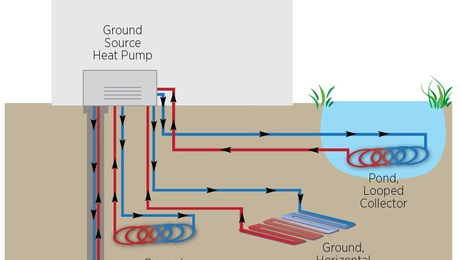
Open-Loop Systems
Open-loop systems use groundwater or surface water as the heat exchange fluid. In these systems, water is drawn from a well or other water source, circulated through the heat pump, and then returned to the source or discharged at a different location. Open-loop systems are highly efficient but depend on the availability and quality of the water source. They also require careful consideration of environmental regulations and potential impacts on local water resources.
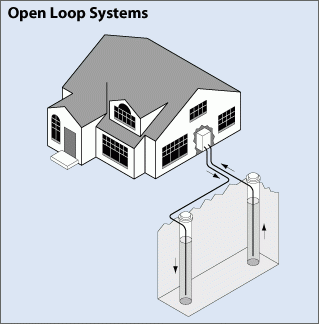
Benefits of Geothermal Heating and Cooling
Geothermal heating and cooling systems offer a range of benefits that make them an attractive option for residential projects. These advantages span energy efficiency, cost savings, environmental impact, and more.

Energy Efficiency
One of the most significant benefits of geothermal systems is their exceptional energy efficiency. Geothermal heat pumps can achieve efficiency levels of 300-600%, compared to the 175-250% efficiency of traditional air-source heat pumps. This high efficiency is due to the stable temperature of the ground, which provides a reliable source of heat in the winter and a heat sink in the summer. As a result, homeowners can enjoy consistent indoor comfort while using significantly less energy.
Long Term Cost Savings
Although the initial installation cost of geothermal systems can be higher than conventional HVAC systems, the long-term cost savings are substantial. Reduced energy consumption leads to lower utility bills, and many homeowners find that their geothermal systems pay for themselves within 5-10 years through energy savings alone. Additionally, geothermal systems are eligible for various tax credits and incentives, further enhancing their financial benefits. For more information regarding sustainable energy-efficient homes visit our article here.
Environmental Benefits
Geothermal systems are environmentally friendly, as they produce far fewer greenhouse gas emissions than fossil fuel-based heating and cooling systems. By relying on the earth’s natural heat, these systems help reduce the overall carbon footprint of a home. Moreover, geothermal systems do not require combustion, eliminating the risk of carbon monoxide poisoning and reducing air pollution.
Improved Energy Rating Scores
Homes equipped with geothermal heating and cooling systems often achieve higher Home Energy Rating System (HERS) scores. A higher HERS score indicates a more energy-efficient home, which can increase property value and appeal to environmentally conscious buyers. Improved energy ratings also align with sustainable building certifications, such as LEED, further enhancing the marketability and prestige of high-end residential properties. Wondering if you need a HERS rating? Try our “Do I Need a HERS Rating?” calculator to find out.

Equipment Lifespan
Geothermal heat pumps are known for their durability and long lifespan. The underground components, such as the ground loop, can last 50 years or more, while the indoor heat pump unit typically has a lifespan of 20-25 years. This longevity reduces the need for frequent replacements and maintenance, offering homeowners peace of mind and additional cost savings over time.
Flexibility in Equipment Location
Geothermal systems offer flexibility in equipment placement, as the heat pump unit can be installed indoors, often in a basement or utility room. This flexibility allows for better space utilization and minimizes exposure to outdoor elements, which can prolong the life of the equipment.
Reduced Noise Levels
Additionally, geothermal systems operate quietly, with noise levels comparable to a refrigerator. This low noise output enhances the comfort and tranquility of high-end residential properties, making them an ideal choice for any home.
Comparing Geothermal Heating and Cooling with Other Systems
When considering heating and cooling options for high-end residential properties, it’s important to weigh the pros and cons of various systems. Here’s a comparison of geothermal systems with natural gas, oil, fossil fuels, and air source heat pumps.
Geothermal Heat Pump Tradeoffs and Design Considerations
When considering the installation of geothermal heat pumps for residential properties, it’s important to be aware of certain tradeoffs and design considerations. These factors can significantly impact the feasibility, cost, and overall performance of the system.

High Up-Front Cost
One of the primary tradeoffs associated with geothermal heat pumps is the high up-front cost. The installation of a geothermal system can be approximately three times more expensive than traditional heating and cooling systems. This higher initial investment is due to several factors:
- Drilling and excavation: Installing the ground loop system involves drilling boreholes or excavating trenches, which requires specialized equipment and labor.
- Equipment costs: Geothermal heat pumps and associated components are typically more expensive than conventional HVAC equipment.
- Design and engineering: Properly designing a geothermal system requires detailed site assessments, thermal conductivity testing, and custom engineering solutions.
While the initial cost is substantial, it is important to consider the long-term benefits. Geothermal systems offer significant energy savings, reduced operating costs, and potential government incentives that can offset the initial investment over time. Additionally, the long lifespan and low maintenance requirements of geothermal heating and cooling further enhance their financial viability in the long run.
Integration with Overall Site Design
Another critical consideration is the coordination of the geothermal system with the overall site design. Successful implementation requires careful planning and collaboration among various stakeholders, including architects, engineers, and contractors. Key aspects of site design coordination include:
- Space requirements: The installation of horizontal or vertical ground loops necessitates sufficient space on the property. Horizontal loops require extensive land area, while vertical loops require drilling equipment access.
- Soil and geology: The type of soil and underlying geology can affect the efficiency and feasibility of the ground loop installation. Conducting a thorough site assessment and thermal conductivity test is essential to determine the most suitable installation method.
- Landscaping and aesthetics: Integrating the geothermal system with the property’s landscaping and aesthetic considerations is important. The design should ensure minimal disruption to the landscape and accommodate any future landscaping or development plans.
- Water source availability: For pond/lake or open-loop systems, the availability and quality of a nearby water source must be evaluated. Ensuring compliance with local water usage regulations and environmental guidelines is also necessary.
- Building integration: Coordinating the installation of the geothermal heat pump with the building’s existing mechanical systems, such as ductwork or radiant floor heating, is crucial for seamless operation and efficiency.
Effective site design coordination helps optimize the performance of the geothermal system and ensures that it meets the specific needs and constraints of the property. By addressing these considerations early in the planning process, homeowners and design professionals can achieve a successful and efficient geothermal installation that maximizes the benefits of this sustainable technology.
Is a Geothermal System Right For You?
Deciding whether a geothermal system is the right choice for your property involves several key considerations. By understanding the expertise required, project-specific factors, and the roles of different professionals, you can make an informed decision.
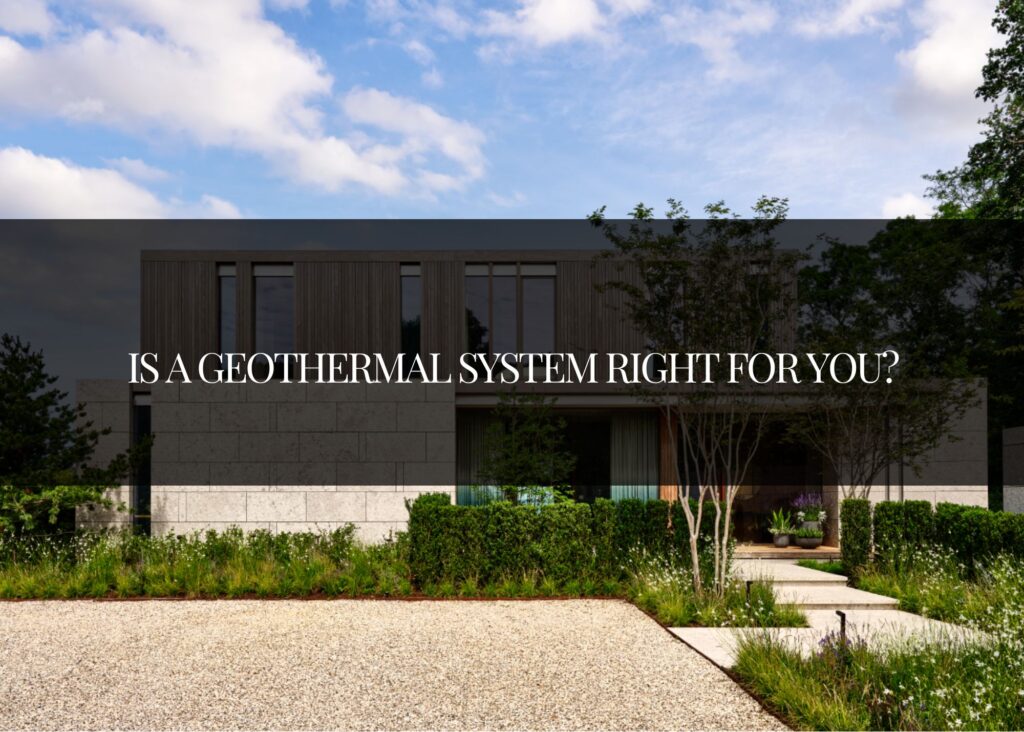
Key Factors to Consider for Your Project
Several project-specific factors must be taken into account when deciding on a geothermal system:
- Initial investment: As discussed, geothermal systems have a high up-front cost, typically around three times more than traditional HVAC systems. It’s important to assess your budget and consider the long-term savings and potential incentives.
- Property suitability: Ensure that your property has the necessary space and geological conditions for the installation of the ground loop system, whether it be horizontal, vertical, or pond/lake.
- Energy needs: Evaluate your property’s heating and cooling demands to determine if a geothermal system can meet these requirements effectively.
- Environmental impact: Consider the environmental benefits of reducing greenhouse gas emissions and lowering your carbon footprint with a geothermal system.
- Maintenance requirements: Geothermal systems require less maintenance than traditional systems, but it’s important to understand the long-term upkeep involved.
By carefully considering these factors, you can determine whether a geothermal system aligns with your project goals and constraints.
Role of MEP Engineer Compared to Contractor
Understanding the roles of different professionals is key to a successful geothermal system integration:
MEP Engineer (Mechanical, Electrical, and Plumbing):
MEP engineers are integral to the design and implementation of a geothermal system. Their responsibilities include:
- System design: MEP engineers are responsible for the comprehensive design of the geothermal system, ensuring it integrates effectively with the property’s overall MEP systems.
- Efficiency optimization: They focus on optimizing the system’s efficiency, performance, and reliability.
- Technical oversight: Provide technical oversight during installation, ensuring that all components are correctly implemented and functioning as intended.
Contractor
Contractors are vital for the practical execution of the geothermal system design. Their responsibilities include:
- Installation execution: Contractors handle the physical installation of the geothermal system, including drilling, trenching, and equipment setup.
- Coordination with engineers: Work closely with MEP engineers to ensure the design specifications are met and address any on-site challenges that arise.
- Compliance and safety: Ensure that the installation complies with all safety regulations and building codes.
While both MEP engineers and contractors play vital roles, the MEP engineer’s expertise in system design and integration is critical for the successful implementation of a geothermal system. Their oversight ensures that the system performs efficiently and meets all technical requirements, while contractors bring the design to life through skilled execution.
DAE’s Expertise
Implementing a geothermal system requires specialized knowledge in design, assessment, and engineering. At DAE, our team can help to:
- Conduct detailed site assessments: Evaluate soil composition, groundwater availability, and thermal conductivity to determine the most suitable geothermal system for your property.
- Design custom solutions: Develop tailored designs that integrate seamlessly with your property’s specific characteristics and heating/cooling needs.
- Ensure compliance: Navigate local regulations and environmental guidelines to ensure your system meets all necessary standards.
By leveraging the expertise of DAE professionals, you can ensure that your geothermal system is optimally designed and installed, maximizing its efficiency and longevity.
